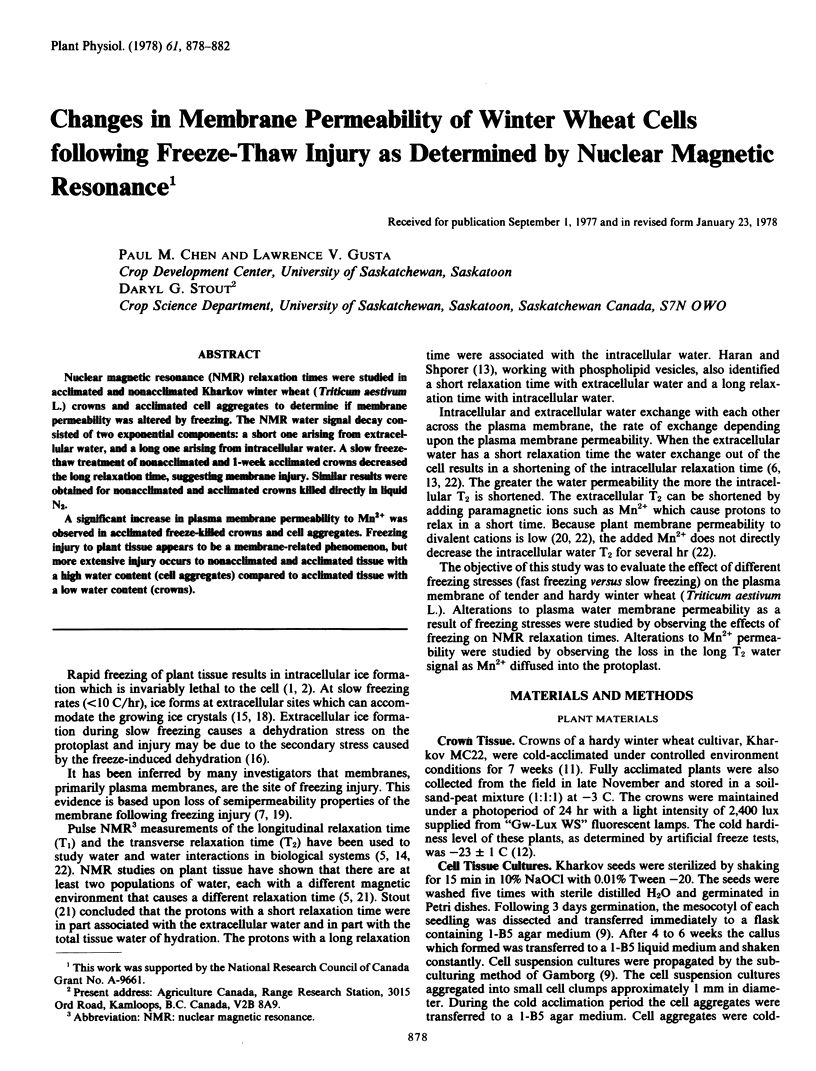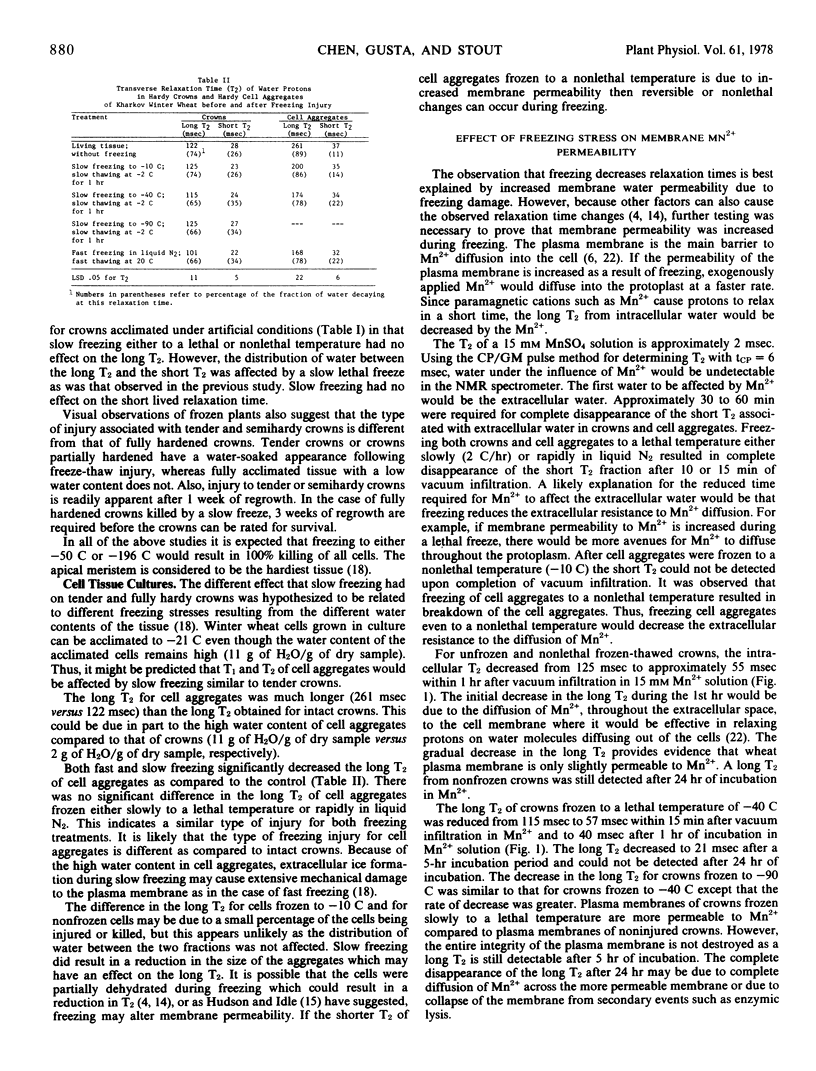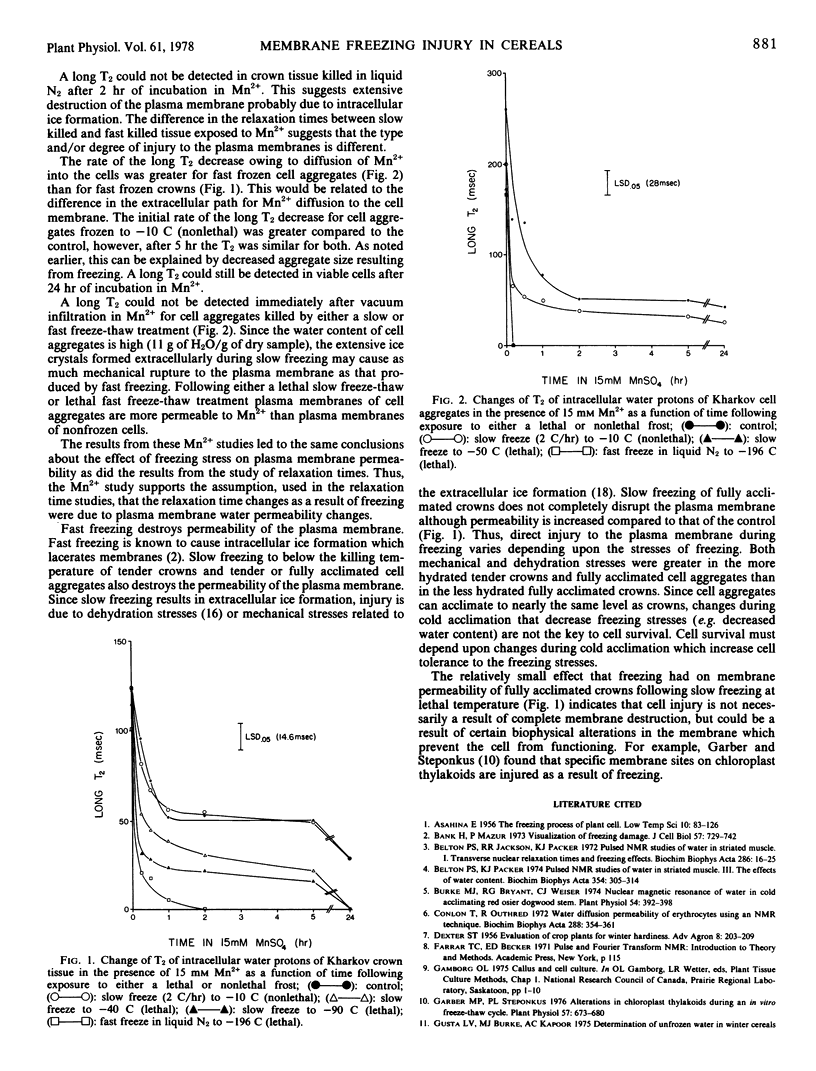Abstract
Nuclear magnetic resonance (NMR) relaxation times were studied in acclimated and nonacclimated Kharkov winter wheat (Triticum aestivum L.) crowns and acclimated cell aggregates to determine if membrane permeability was altered by freezing. The NMR water signal decay consisted of two exponential components: a short one arising from extracellular water, and a long one arising from intracellular water. A slow freezethaw treatment of nonacclimated and 1-week acclimated crowns decreased the long relaxation time, suggesting membrane injury. Similar results were obtained for nonacclimated and acclimated crowns killed directly in liquid N2.
A significant increase in plasma membrane permeability to Mn2+ was observed in acclimated freeze-killed crowns and cell aggregates. Freezing injury to plant tissue appears to be a membrane-related phenomenon, but more extensive injury occurs to nonacclimated and acclimated tissue with a high water content (cell aggregates) compared to acclimated tissue with a low water content (crowns).
Full text
PDF




Selected References
These references are in PubMed. This may not be the complete list of references from this article.
- Bank H., Mazur P. Visualization of freezing damage. J Cell Biol. 1973 Jun;57(3):729–742. doi: 10.1083/jcb.57.3.729. [DOI] [PMC free article] [PubMed] [Google Scholar]
- Belton P. S., Jackson R. R., Packer K. J. Pulsed NMR studies of water in striated muscle. I. Transverse nuclear spin relaxation times and freezing effects. Biochim Biophys Acta. 1972 Nov 24;286(1):16–25. doi: 10.1016/0304-4165(72)90084-0. [DOI] [PubMed] [Google Scholar]
- Belton P. S., Packer K. J. Pulsed NMR studies of water in striated muscle. 3. The effects of water content. Biochim Biophys Acta. 1974 Jul 4;354(2):305–314. doi: 10.1016/0304-4165(74)90015-4. [DOI] [PubMed] [Google Scholar]
- Burke M. J. Nuclear magnetic resonance of water in cold acclimating red osier dogwood stem. Plant Physiol. 1974 Sep;54(3):392–398. doi: 10.1104/pp.54.3.392. [DOI] [PMC free article] [PubMed] [Google Scholar]
- Conlon T., Outhred R. Water diffusion permeability of erythrocytes using an NMR technique. Biochim Biophys Acta. 1972 Nov 2;288(2):354–361. doi: 10.1016/0005-2736(72)90256-8. [DOI] [PubMed] [Google Scholar]
- Garber M. P., Steponkus P. L. Alterations in Chloroplast Thylakoids during an in Vitro Freeze-Thaw Cycle. Plant Physiol. 1976 May;57(5):673–680. doi: 10.1104/pp.57.5.673. [DOI] [PMC free article] [PubMed] [Google Scholar]
- Gusta L. V. Determination of unfrozen water in winter cereals at subfreezing temperatures. Plant Physiol. 1975 Nov;56(5):707–709. doi: 10.1104/pp.56.5.707. [DOI] [PMC free article] [PubMed] [Google Scholar]
- Haran N., Shoporer M. Study of water permeability through phospholipid vesicle membranes by 17O NMR. Biochim Biophys Acta. 1976 Apr 5;426(4):638–646. doi: 10.1016/0005-2736(76)90128-0. [DOI] [PubMed] [Google Scholar]
- Hazlewood C. F., Chang D. C., Nichols B. L., Woessner D. E. Nuclear magnetic resonance transverse relaxation times of water protons in skeletal muscle. Biophys J. 1974 Aug;14(8):583–606. doi: 10.1016/S0006-3495(74)85937-0. [DOI] [PMC free article] [PubMed] [Google Scholar]
- Sukumaran N. P., Weiser C. J. Freezing injury in potato leaves. Plant Physiol. 1972 Nov;50(5):564–567. doi: 10.1104/pp.50.5.564. [DOI] [PMC free article] [PubMed] [Google Scholar]


